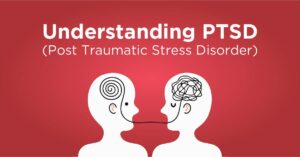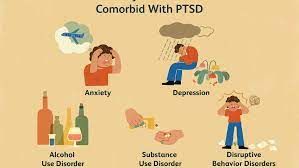Post-traumatic stress disorder, or PTSD, is a mental health condition that can develop after someone experiences a traumatic event. This could be anything from a natural disaster to sexual assault. It’s important to be able to recognize the symptoms of PTSD so that you can get help if you need it. In this blog post, we will discuss 5 different types of PTSD and how to get help if you think you might have it.
Contents
Understanding PTSD
 PTSD refers to a post-traumatic stress disorder, a condition that can develop after someone has been through a traumatic event. It is natural to feel afraid during and after a traumatic experience. Fear triggers many survival instincts, such as the “fight-or-flight” response, which can help us protect ourselves from harm.
PTSD refers to a post-traumatic stress disorder, a condition that can develop after someone has been through a traumatic event. It is natural to feel afraid during and after a traumatic experience. Fear triggers many survival instincts, such as the “fight-or-flight” response, which can help us protect ourselves from harm.
Most people who go through a traumatic event have some type of reaction, but they eventually adjust and cope with the experience. For people with PTSD, however, the symptoms don’t go away and can get worse over time. The condition can be debilitating and prevent someone from functioning normally.
It is important to understand the different types of PTSD so that you can recognize the symptoms and get the help you need.
Five Types Of PTSD
There are five different types of PTSD, each with its own set of symptoms. It’s important to be aware of the different types so you can better recognize the symptoms in yourself or a loved one and get the help you need.
Let’s take a look at the five types of PTSD:
Normal Stress Response
This is the type of stress response that everyone experiences. It is the body’s natural way of responding to a traumatic or stressful event. Also, it is believed that this type of stress response can actually help people cope with and recover from a traumatic event.
Normal stress affects the immune system, nervous system, and endocrine system. This situation is supposed to activate the “fight-or-flight” response. When this happens, the individual experiences an increased heart rate, higher blood pressure, and faster breathing. The symptoms of normal stress response include:
- increased heart rate
- sweating
- trembling or shaking
- shortness of breath
- muscle tension
- fatigue
So, when a situation triggers the “fight-or-flight” response, it is a normal stress reaction. But, if this reaction becomes chronic, it can lead to PTSD.
Acute Stress Disorder
 This is a type of PTSD that develops within a month of a traumatic event. The symptoms are similar to PTSD, but they don’t last as long. Acute stress disorder may turn into PTSD if the symptoms last more than a month. According to studies, about 50% of people who have acute stress disorder will develop PTSD.
This is a type of PTSD that develops within a month of a traumatic event. The symptoms are similar to PTSD, but they don’t last as long. Acute stress disorder may turn into PTSD if the symptoms last more than a month. According to studies, about 50% of people who have acute stress disorder will develop PTSD.
For example, let’s say you were in a car accident. You may have symptoms of acute stress disorder, such as:
- feeling numb or detached from your surroundings
- having trouble sleeping
- being easily startled
- having negative changes in your thinking or mood
If these symptoms last more than a month, you may have PTSD. In fact, you may not even realize you have PTSD until months or even years after the event. That’s why it’s important to be aware of the symptoms and get help if you need it.
Complex PTSD
Complex PTSD usually occurs when someone has experienced long-term or chronic trauma, such as child abuse, domestic violence, or being held captive. It can also occur in response to a natural disaster or living in a war zone. People with complex PTSD often have difficulty regulating their emotions.
The people who have suffered the most complex trauma are at the highest risk for developing this disorder. Moreover, the signs and symptoms of complex PTSD can be emotional and physical too, so you need to be very careful and read the next points to see if you or somebody close to you is suffering from it.
Signs and symptoms of complex PTSD may include:
- feeling alienated from other people
- feeling permanently damaged or worthless
- losing interest in activities that used to be enjoyable
- having trouble experiencing positive emotions
- feeling excessively suspicious or guarded
- being easily startled or frightened
- having difficulty controlling anger
- having flashbacks
- suffering from intrusive memories
- avoiding people or places that are reminders of the trauma
- feeling emotionally numb and disconnected from others
With these symptoms, you will definitely have a tough time moving on from your traumas. And that’s why it is so important to get help as soon as possible.
Dissociative PTSD
It is often a newly recognized type of PTSD in DSM-V. It is characterized by a feeling of disconnection from oneself. One may feel like they are outside of their own body looking in, or that the world around them isn’t real.
This can happen after a single traumatic event, but it is more likely to occur if someone has experienced multiple traumas. People with dissociative PTSD often struggle with depression, anxiety, and substance abuse. They may also have dissociative disorders such as:
- Dissociative amnesia
- Depersonalization disorder
Also, there are a few signs that may indicate that someone has dissociative PTSD, such as:
- Avoiding people, places, or things that remind them of the trauma
- Losing interest in activities they used to enjoy
- Feeling detached from other people
- Experiencing memory problems
- Feeling like the world around them isn’t real
If you or someone you know is struggling with dissociative PTSD, it’s important to seek professional help. Trauma-focused cognitive-behavioral therapy (TF-CBT) has been shown to be an effective treatment for this type of PTSD.
Co-morbid PTSD
 People with co-morbid PTSD often have two or more diagnoses. This is about co-occurring two mental disorders. The most common mental disorders that people experience along with PTSD are:
People with co-morbid PTSD often have two or more diagnoses. This is about co-occurring two mental disorders. The most common mental disorders that people experience along with PTSD are:
- Depression
- Anxiety disorders
- Panic attacks
- Substance abuse disorders
This happens because the person’s coping mechanisms are overwhelmed. They may have developed unhealthy coping mechanisms to deal with their PTSD. This can lead to further problems down the road. Some symptoms to recognize in people with co-morbid PTSD are:
- Withdrawing from friends and family
- Isolation
- Unhealthy coping mechanisms like drinking or drug use
- Avoidance behaviors
- Hopelessness
These symptoms can be difficult to deal with on their own, let alone when someone is dealing with multiple mental disorders. If you think you may have co-morbid PTSD, it’s important to seek help from a mental health professional. They can help you develop healthy coping mechanisms and work through your disorders.
So, these are the most common types of PTSD that you should be aware of. And further, get the help you or your loved ones need. Remember, PTSD is a serious mental disorder that should not be taken lightly.
Treatment Options For PTSD
When you are ready to seek help, there are many options available for treating PTSD. Some of the options include:
Therapy
There are several therapies for types of PTSD, each with its own specific goal. The type of therapy will be matched to your individual needs. Here are some common therapies for all five types of PTSD:
- Cognitive-behavioral therapy (CBT): This is the most common type of therapy for PTSD. CBT helps you understand how your thoughts and beliefs about the event are affecting you now. It also teaches you how to change those thoughts and beliefs to improve your symptoms.
- Eye movement desensitization and reprocessing (EMDR): This therapy uses eye movements or other forms of bilateral stimulation to help you process the trauma.
- Prolonged exposure therapy (PE): This therapy helps you face your fears and work through the trauma. You will talk about the event in detail and gradually expose yourself to more and more reminders of the event.
- Stress inoculation training (SIT): This therapy helps you learn how to manage your stress. It teaches you relaxation techniques and ways to cope with anxiety.
So therapies are numerous and it’s important to find one that is the best match for you and your situation. And for this, you need to consult with a mental health professional.
Medication
There are also many medications that can be used to treat PTSD. The most common types of medication include:
- Antidepressants
- Anti-anxiety
- Anti-psychotic
These medications can help to improve sleep, reduce anxiety, and make it easier to cope with flashbacks and intrusive thoughts. It is important to work with a mental health professional to find the right medication for you. Also, before starting any medication you should discuss some of the things with your doctor, these include:
- Your past medical history
- Any other medications you are taking
- Possible side effects of the medication
Your doctor will also want to monitor you closely to make sure that the medication is working and that you are not having any adverse reactions.
Support groups
 It might sound counterintuitive, but talking to others who have been through similar experiences can be therapeutic. In fact, it’s often one of the most effective treatments for PTSD. No matter, if you are taking therapies already, support groups holds a unique value.
It might sound counterintuitive, but talking to others who have been through similar experiences can be therapeutic. In fact, it’s often one of the most effective treatments for PTSD. No matter, if you are taking therapies already, support groups holds a unique value.
When you’re in a group, you realize that you are not alone in your experiences or your feelings. You hear about other people’s coping mechanisms and get to share your own. In addition, the group members can provide practical advice for dealing with specific symptoms. Hence, consider joining a PTSD support group in your area.
So, overall these are some professional helpful tips for people who think they might have PTSD. If you identify with any of the symptoms, please reach out to a mental health professional for help. And, remember that everyone experiences trauma differently—there is no “right” or “wrong” way to heal.
Other Helpful Tips To Self-Care
During PTSD, it is easy to focus on negative and traumatic memories. However, it is essential to also focus on the positive aspects of your life as well. This can be difficult, so here are a few tips for you to help keep a healthy focus:
Challenge your negative thoughts
Negative thoughts are assumed easily but they are really harmful to your condition. So whenever you have a negative thought, ask yourself whether it’s really true or not. If the answer is no, then try to come up with three positive things about that situation.
For example, you can challenge the thought “I am not good enough” by thinking of three things you are proud of that show how capable you are. This will help to reduce the power of negative thoughts and give you a more balanced view of yourself and the situation.
Make time for activities that make you happy
It is important to do things that make us happy and help us relax. This can be different for everyone, but some examples include:
- reading,
- listening to music,
- spending time in nature, or
- talking to friends.
Some happy and enjoyable activities will make you feel relaxed and help to reduce stress. When you have more free time, try out different activities and see which ones work better for you.
Get enough sleep
Sleep is vital for our physical and mental health, yet it is often one of the first things to suffer when we are stressed. Getting enough sleep can be difficult during PTSD, but there are a few things you can do to help:
- try to stick to a regular sleep schedule as much as possible,
- limit caffeine and alcohol,
- create a relaxing bedtime routine, such as reading or taking a bath.
Getting enough sleep will help improve your mood, concentration, and energy levels.
Talk to someone you trust
This is often a vital step in the healing process. Talking to someone you trust about your experiences and feelings can help you feel supported and less alone. This person could be a friend, family member, therapist, or anyone else too who you feel comfortable talking.
Because sometimes, sharing your feelings with your loved ones can be difficult, you can also join a support group or online forum. This can provide an outlet to share your experiences with people who understand what you’re going through.
Practice healthy coping
 It is essential to choose healthy coping mechanisms when managing PTSD. Some helpful coping mechanisms include:
It is essential to choose healthy coping mechanisms when managing PTSD. Some helpful coping mechanisms include:
- Journaling
- Relaxation techniques
- Mindfulness
- Healthy diet
- Exercise
- Deep breathing exercises
It is also important to avoid unhealthy coping mechanisms such as alcohol or drug abuse, which can worsen symptoms. Moreover, healthy mechanisms can help you to better manage your PTSD and improve your quality of life.
So, these are some things you can try to help you cope with your PTSD. Remember, you are not alone in this and there is help available. If you or someone you know is struggling with PTSD, don’t hesitate to reach out for professional help. Because types of PTSD can be different, it is necessary to seek out a professional who can give you an accurate diagnosis and treatment plan.
Conclusion
To conclude, types of PTSD are many and each comes with its own set of symptoms. However, no matter the type, it is important to get help if you think you may be suffering from this disorder. PTSD can be debilitating and make it hard to live a normal life. But with proper treatment, most people are able to recover and live healthy lives.
For more information, please contact MantraCare. PTSD or Post-Traumatic Stress Disorder is a mental health condition that affects people who have experienced or witnessed a traumatic event. If you have any queries regarding Online PTSD Counseling experienced therapists at MantraCare can help: Book a trial PTSD therapy session


